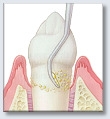Treating Periodontal Disease Without Surgery
The goal of these treatments is to create conditions that enable tissues in the mouth to heal.
This is done by reducing plaque, infection, and other causes of periodontal disease. In about 4 to 8 weeks, you’ll have another evaluation. Depending on various factors, surgery may be the next step.
Scaling and Root Planing
The first non-surgical step usually involves a special cleaning, called scaling and root planing. This is sometimes referred to as “periodontal” or “deep” cleaning. Scaling and root planing is a method of treating periodontal disease when pockets are greater than 3mm. Scaling is used to remove plaque and tarter beneath the gum line. A local anesthetic may be given to reduce any discomfort. Using an instrument called a small scaler or an ultrasonic cleaner, plaque and tartar are carefully removed down to the bottom of each periodontal pocket. The tooth’s root surfaces are then smoothed or planed. This procedure helps gum tissue to heal and periodontal pockets to shrink. The procedure also makes it more difficult for plaque to accumulate along the root surfaces.
 Scaling
Scaling
Scaling at and just below the gum line reaches tartar deposits that can’t be removed in an ordinary dental cleaning.
 Root Planing
Root Planing
Root planing smooths rough spots on the roots where bacteria collect.
Depending on the extent of the disease, your dentist may recommend that one or more sections (quadrants) of the mouth be treated with scaling and root planing. Treatment requires one or more visits. You’ll be given instructions on how to care for your healing teeth and gums.
Further Treatment
Antibiotics
 Your dentist also may recommend medications to help control infection and pain, or to aid healing. These medications could include a pill, a mouth rinse, or a substance that the dentist places directly in the periodontal pocket after scaling and root planing.
Your dentist also may recommend medications to help control infection and pain, or to aid healing. These medications could include a pill, a mouth rinse, or a substance that the dentist places directly in the periodontal pocket after scaling and root planing.
Bite Correction
 Bite problems such as an uneven bite can worsen bone loss. Grinding or clenching the teeth may contribute to the problem. A splint or other ways of adjusting the bite can reduce pressure and help control the damage.
Bite problems such as an uneven bite can worsen bone loss. Grinding or clenching the teeth may contribute to the problem. A splint or other ways of adjusting the bite can reduce pressure and help control the damage.
Home Care
 Maintaining good oral hygiene at home and continued follow-up by your dentist is essential to help prevent periodontal disease from becoming more serious or recurring.
Maintaining good oral hygiene at home and continued follow-up by your dentist is essential to help prevent periodontal disease from becoming more serious or recurring.
If you smoke or chew tobacco products, it is important to quit. Your dentist may also advise you to talk to a physician about any other health problems that may be affecting your oral health.
